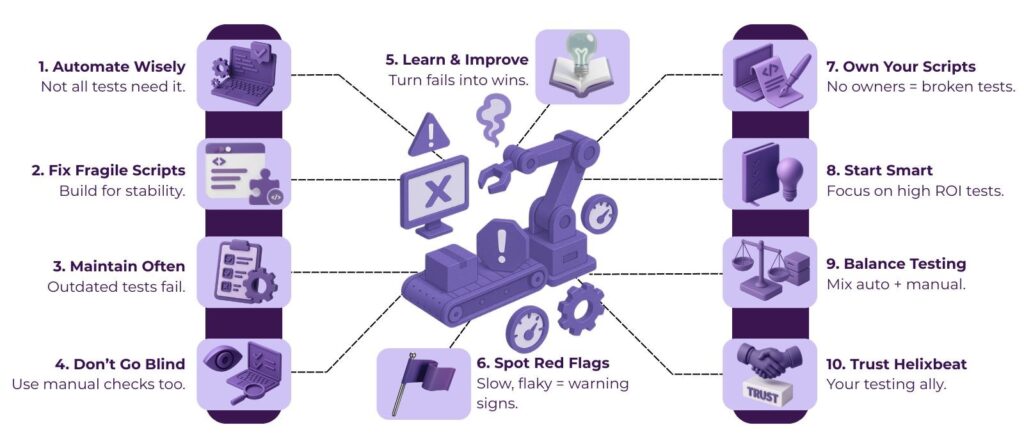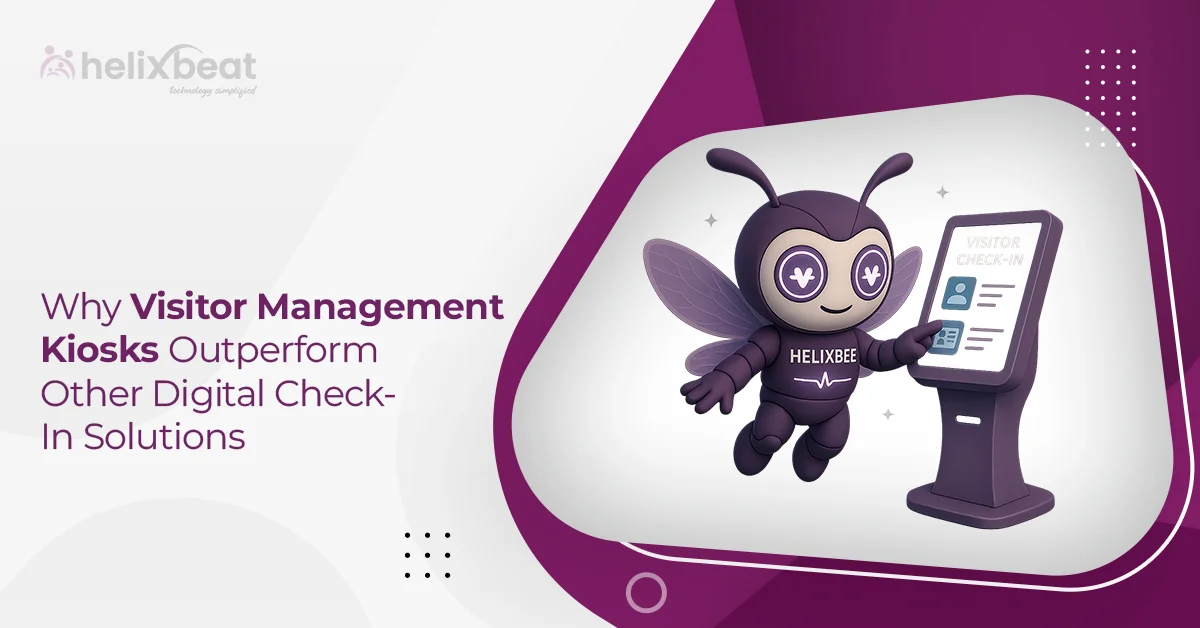Have you ever put full trust in automation testing services, only to face unexpected failures that disrupted your project? For many teams, relying on automated tests feels like a silver bullet—one that promises speed, accuracy, and efficiency. But what happens when automation misses the mark? How do automated software testing companies bounce back from those failures?
Helixbeat, a leader in automation testing services, knows these challenges all too well. They’ve witnessed—and learned from—automation failures that could have derailed projects but instead became valuable lessons. This blog uncovers some of the most common reasons automation goes wrong, how to detect warning signs early, and best practices from Helixbeat to keep your test automation on track.

Table of Contents
Why Does Automation Fail? Understanding the Root Causes
Automation testing is powerful but not foolproof. Knowing why it fails can help prevent future disasters.
Is Automation Always the Right Choice?
Automation testing company teams sometimes rush to automate everything, thinking it will save time. However, not every test case is suitable for automation. Trying to automate unstable or frequently changing features leads to fragile tests that fail often.
Poorly Designed Test Scripts
Automation testing services rely heavily on scripts. If these scripts lack clarity and maintainability, they break easily. Issues like lack of modularity, hard-coded values, and missing error handling cause frequent false positives or negatives.
Insufficient Maintenance
Automated tests require regular updates to keep pace with product changes. When teams neglect this, tests become outdated and irrelevant, wasting time chasing false bugs.
Over-Reliance on Automation
Sometimes, teams depend solely on automation and overlook manual exploratory testing. This blind spot allows critical issues to slip through, as automated tests cannot catch everything, especially UI or usability problems.
Real-Life Failures That Can Teach You Critical Lessons
Every failure is a chance to learn. Here are some real scenarios where automation testing failed and how those experiences shaped better practices.
Case 1: The Overnight Script Break
A fintech startup automated their regression suite to run overnight. One morning, the entire suite failed due to a minor UI change that was overlooked in the automation scripts. This halted the release process and delayed deployment by two days.
Lesson: Automation scripts must be designed to be resilient to minor UI changes and regularly reviewed after product updates.
Case 2: The Blind Spot Bug
An e-commerce platform relied solely on automated test coverage. However, a critical checkout flow bug escaped detection because the automated tests didn’t cover the payment gateway’s dynamic third-party widgets.
Lesson: Teams at an automation testing company should complement automation with manual testing for dynamic or complex features.
Case 3: The Maintenance Nightmare
A large SaaS provider accumulated thousands of automated tests over the years without proper management. Many tests were redundant, flaky, or irrelevant, which slowed down the entire CI/CD pipeline.
Lesson: Regular pruning and optimization of test suites are vital to keep automation testing services efficient and reliable.
How to Detect When Automation is Going Off Track?
Recognizing early signs of automation failure helps teams take corrective action before it impacts delivery.
Frequent False Failures
If your automation testing services produce false alarms regularly, that’s a red flag. It wastes developers’ time and erodes trust in the test results, making the automation unreliable.
Increasing Test Execution Time
Automation should speed up testing, not slow it down. When test suites balloon in size and take hours to run, they lose their value for rapid feedback and can delay releases.
Low Test Coverage of Critical Paths
Automation is failing if important business flows or integrations remain untested due to complexity or neglect. This gap often allows critical bugs to slip through, undermining overall quality.
Lack of Clear Ownership
Without a dedicated team managing automation scripts, tests become outdated quickly and lose effectiveness. This challenge is common among many automation testing companies and needs proactive management to keep automation efficient.
Best Practices to Avoid Automation Failures
Helixbeat’s expertise as a premier automation testing company shines through the proven methods they apply to prevent common pitfalls.
Start with a Clear Automation Strategy
Identify which tests to automate based on ROI, stability, and repeatability. Focus on high-risk areas and core functionalities to maximize the benefits of your automation testing services.
Design Robust and Modular Scripts
Adopt best practices such as parameterization, reusable functions, and exception handling. This approach reduces brittleness and makes maintenance easier for your test automation services.
Maintain Tests Actively
Integrate test maintenance into sprint cycles. Remove obsolete tests and update existing ones in sync with product changes to keep your automation relevant and effective.
Balance Automation with Manual Testing
Retain exploratory and UI testing as manual processes where automation falls short. This hybrid approach helps catch more defects and complements your automated software testing company efforts.
Leverage Scalable Test Automation Frameworks
Utilize modern tools that support parallel execution, cloud testing, and seamless integration with CI/CD pipelines. These features optimize test speed and reliability, essential for any automation testing company.
By following these best practices, teams can significantly reduce the risk of automation failures, increase confidence in automated tests, and improve overall software quality. Helixbeat’s comprehensive automation testing services and deep industry knowledge ensures your automation efforts align with business goals and deliver measurable value.
How Helixbeat Turns Testing Failures into Success?
At Helixbeat, failures in automation are seen as learning opportunities that strengthen test frameworks and build resilience.
Tailored Testing as a Service (TaaS)
Helixbeat’s automation testing services are customized to fit each client’s technology stack, business needs, and team capabilities. This personalized approach drastically reduces the risk of failures.
Continuous Improvement Cycle
The team actively monitors test performance, false failures, and execution times. Through actionable reports and ongoing feedback, Helixbeat continuously optimizes testing efficiency and reliability.
Flexible Engagement Models
Whether you require a dedicated team, on-demand specialists, or fully managed testing, Helixbeat adapts to your workload and timelines without compromising quality.
Industry-Leading Tools and Expertise
Using more than 20 advanced tools—including Selenium, JMeter, and Appium—Helixbeat delivers high accuracy and faster release cycles, turning automation testing services into a competitive advantage for your business.
As a leading automation testing company, Helixbeat’s blend of technology, expertise, and agility ensures your test automation stays on track and drives success.
When Should You Consider Outsourcing to an Automation Testing Company?
Knowing when your internal team is stretched too thin or lacks automation expertise is crucial for project success.
Facing Tight Deadlines with Growing Test Needs
Outsourcing to a specialist automation testing company helps scale testing quickly and efficiently during critical periods.
Lack of In-House Automation Skills
Professional automation testing services bring deep knowledge of frameworks, scripting, and maintenance best practices, filling skill gaps effectively.
Managing Complex or Legacy Systems
Third-party experts can handle complicated test automation scenarios requiring specialized tools or cross-platform support, which may challenge internal teams.
By partnering with an experienced automation testing company, you gain access to scalable resources and expert knowledge that keep your projects on track without compromising quality.
Final Words
Automation testing cannot be perfect. But when managed well, it becomes one of the most powerful tools in software delivery. The failures we’ve discussed show that automation is a journey—one that needs clear strategy, regular upkeep, and balance.
Helixbeat’s Testing as a Service model makes sure automation testing services are customized, reliable, and scalable. With Helixbeat’s experience, your automated software testing company can avoid common mistakes and speed up quality delivery without surprises.
If your automation testing is having problems or you want to build a strong test automation framework, it’s time to work with Helixbeat. Their flexible engagement options and proven tools can improve your testing process and protect your product’s future.
FAQs
1. How can I maintain automation tests effectively?
Incorporate regular reviews, update tests with product changes, prune obsolete tests, and use modular scripting for easier maintenance.
2. Should I automate all test cases?
No. Focus on repetitive, stable, and critical tests. Complex UI or exploratory tests are better suited for manual testing.
3. How do automation testing services help startups?
They offer scalable, efficient testing that accelerates releases while maintaining quality, often with flexible models to match changing needs.
4. How often should automation scripts be updated?
Ideally, scripts should be reviewed and updated with every significant product change or sprint cycle to remain relevant.
5. What is Testing as a Service (TaaS)?
TaaS is an outsourced testing model where expert teams manage your entire testing lifecycle, providing flexible and cost-effective solutions.














